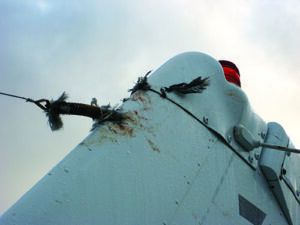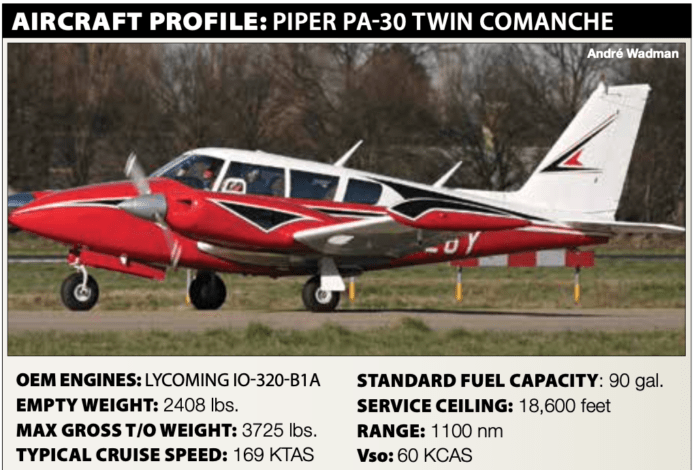I hit a bird once. I was flying a Piper Arrow II, on short final, with landing gear and full flaps extended, when I saw the bird ahead of the airplane. It was maneuvering and, from my perspective, flew in a circle as we neared each other, then disappeared under the left wing. I heard a muffled thump as it went by. I still had three green lights and the airplane remained controllable, so I landed.
After shutting down, I inspected the left wing and landing gear, finding a trace of blood and a very small feather associated with a slight depression in the wing’s leading edge. The bird hit the outboard portion of the grille covering the left wing’s fresh-air inlet, where the wing root fairing joins the Arrow II’s leading edge. History did not record its fate. It did, however record that the first reported bird strike involved Orville Wright, in 1905. In other words, bird strikes have been a “thing” since the beginning.
Birds and other wildlife pose a distinct threat to aircraft of all sizes and types. Just ask retired US Airways captain and current U.S. ambassador to ICAO Chesley “Sully” Sullenberger if you’re not convinced. Also, aircraft most often encounter them near airports. Weird, huh? Not really. According to the FAA’s Aeronautical Information Manual, 90-plus percent of reported bird strikes occur at or below 3000 feet agl, although ducks and geese “are frequently observed” as high as 7000 feet agl during migration, which typically occurs March through April, and August through November.
Airframe damage is the predominate threat birds pose to piston aircraft, while almost anything powered by a turbine engine is at greater risk for engine damage or failure. According to AOPA, turbine engines “are able to ingest about three small birds (one and one-half pounds) or one medium bird (two and one-half pounds) without failing. The FAA currently considers a large bird to weigh more than four pounds. There is no aircraft engine certified to ingest a large bird without shutting down.”
Bird strikes involving personal aircraft can certainly ruin your day, but they typically aren’t fatal. This month’s accident is pretty much the worst-case scenario.

- According to the Aeronautical Information Manual, four major migratory flyways exist in the U.S.: The Atlantic flyway parallels the Atlantic Coast, the Mississippi Flyway runs south from Canada through the Great Lakes and follows the Mississippi River, the Central Flyway stretches from Canada through Central America and the Pacific Flyway follows the west coast.
- Turbine engine ingestions may result in sudden loss of power or engine failure. Review engine-out procedures, especially when operating from airports with known bird hazards.
- When encountering birds en route, climb to avoid colliding with them. This is good practice because flocking birds generally distribute themselves downward, with lead birds being at the highest altitude.
- Avoid overflight of known areas of bird concentration and flying at low altitudes during bird migration. Charted wildlife refuges and other natural areas contain unusually high local concentrations of birds which may create a hazard to aircraft.
BACKGROUND
On May 11, 2019, at about 1530 Eastern time, a Piper PA-30 Twin Comanche was destroyed when it collided with terrain near Naples, Fla., apparently out of control. The solo private pilot (male, 71) was fatally injured. Visual conditions prevailed. The flight departed Key West, Fla., at an unspecified time and operated on an IFR flight plan.
The en route and initial approach flight phases were apparently uneventful, and at about 1528, the pilot advised the tower he was on a 5.5-mile final to Runway 23, which was his last communication. At that point, the airplane was at about 2185 feet msl. The airplane continued toward the airport until 1529:42, when it began a gradual, arcing, left descending turn. The last radar target was recorded at 1529:55, when the airplane was less than a quarter nautical mile from the accident site, at 750 feet. The airplane collided with terrain about 4.3 miles and 052 degrees from the approach end of Runway 23.
All structural components necessary to sustain flight, and all primary and secondary flight controls remained attached or were located at the accident site. Examination of the right aileron bellcrank revealed neither stop was damaged. Examination of the flight control cables for roll, pitch and yaw revealed they exhibited either tension overload or were cut for recovery; there was no evidence of preimpact failure or malfunction.
The flap actuator jackscrew was extended 1.750 inches, or 11 threads, which equated to between fully retracted and 10 degrees of flap extension. Both main landing gear were retracted in their wheel wells; the nose landing gear actuator position could not be determined due to impact damage. There was no evidence of preimpact failure or malfunction involving the engines and propellers.
The rear seat headrest and two inflatable life vests were located about 440 feet north-northwest of the accident site. A dead Black Vulture, weighing 3.8 pounds, was located among the wreckage. Feathers were found adhering to a blanket located near the separated inboard section of the right wing.Swabs from the headrest and life vests contained either DNA and/or microscopic feathers from a Black Vulture.
The airplane was certificated under Civil Air Regulation 3 (CAR 3) by the FAA’s predecessor agency, the Civil Aeronautics Administration, which did not include a minimum standard for window or windshield structure strength, or bird penetration. The two-piece factory windshield was 0.125-inch thick, with a center post. It was replaced in 1979 with an STC’d one-piece windshield and the center post was removed. There was no requirement for the new windshield to exhibit bird strike resistance. Maximum thickness of the windshield pieces recovered from the accident site was 0.250 inch. The pilot’s autopsy noted the presence of black bird feathers.
PROBABLE CAUSE
The NTSB determined the probable cause(s) of this accident to include: “Incapacitation of the pilot due to a birdstrike through the windshield in front of the pilot’s position, while on approach to land.”
The NTSB amplified its theory of this accident, stating, “Because the Black Vulture was located among the wreckage and because the airplane’s flight path deviation was unannounced, it is likely that the Black Vulture directly impacted and then penetrated the windshield in front of the pilot’s position, which incapacitated him, resulting in an uncontrolled descent.” The NTSB also noted, “The airplane was certificated in accordance with Civil Air Regulation 3, which specified no minimum standard for window or windshield structure strength, or bird penetration.”
If there was any doubt about whether the Black Vulture took down this Twin Comanche, the feathers observed during the pilot’s autopsy should be sufficient evidence. And if you think you’re immune to this kind of accident because you fly a newer airplane—one whose standards generally exceed CAR 3—the only bird-strike resistance required of the windshields aboard Part 23 small airplanes involve those certificated in the Commuter category.
This time of year, birds are especially active in North America. For some tips on where you might find them, and on avoiding them once you do, see the sidebar on the opposite page.




